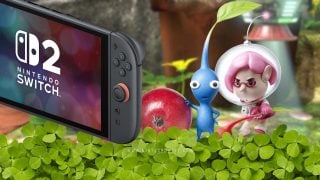Discover what makes Nintendo so special in today’s gaming world through Nintendo Inquirer’s N Factor series!
“What do you love about Nintendo? The more I ask myself that question, the more complex my answer gets. I decided to use the term “N factor” to describe my feelings, because while it’s near impossible to define, Nintendo’s best games all have some undeniable and exclusive allure about them. They’re the result of finely tuned ideas and ideals that collectively personify the company behind them.”
The N Factor series:
-
N Factor, Part 1: Charm
N Factor, Part 2: Respect
N Factor, Part 3: Agelessness
N Factor, Part 4: Immersion
N Factor, Part 5: Creativity
N Factor, Part 6: Unity
N Factor, Part 7: Polish
N Factor, Part 8: Timelessness
N Factor, Part 9: Fun
N Factor, Part 10: Vision
Nintendo is a company that is constantly doing the opposite of what people expect. While its curveball decisions may not always make the most business sense, and often don’t pay off the way the company hopes they will, they’re the reason I’m perpetually excited about Nintendo’s future. We, as gamers, have this unpredictability to thank for the D-pad, shoulder buttons, rumble, and many other features that grace every modern video game controller. It’s easy to take these evolutions for granted, but despite being widely used standards these days, they can all be traced back to their inception on Nintendo systems.
This unpredictable creativity extends beyond control mechanisms. Nintendo also has a long history of inventive use of its beloved characters, beyond the series and genres that they call home. Mario has been in everything, from sports competitions to a dynamic series of role-playing games. Donkey Kong started his gaming career by terrorizing Jumpman, but went on to spawn progeny, star in a long line of platformers, and even got his own rhythm game. The windy pink puff Kirby has eaten, raced, putted, and even painted his way through Dreamland over the years. In probably the best example of all, all of these characters, and dozens more, have brought their unique personalities and skill to an all-out brawl in the Super Smash Bros. Series.
This fall, we were treated to a brand new spin on Nintendo’s main man, Mario. Thirty years after his debut, Super Mario Maker fundamentally changed the way we look at one of Nintendo’s oldest characters and series by letting us, the players, craft his challenges. This avenue of DIY fun isn’t completely new to Nintendo, though; series like Mario Vs. Donkey Kong and WarioWare have featured player created content in recent years, too. But let’s not stop there: We can trace Nintendo’s experiments in creation software back much, much further. In 1992, Mario starred in one of Nintendo’s craziest, most unpredictable, and creative projects ever: Super Nintendo’s Mario Paint.
You want some hard evidence that Mario Paint is kind of bananas? It came packaged with a mouse… and a mousepad. I’m sure you already knew that, but let it sink in for a minute. Think about all of the odd gaming peripherals we’ve seen over the past ten years: motion controls, cameras, stereoscopic 3D screens, and now we’re on the cusp of full on virtual reality. Over twenty years ago Nintendo was silently paving the way to the absurd future we now find ourselves in. I should point to the Virtual Boy here, too, but let’s just leave it at a mention and move on.
As for the game itself, Mario Paint was divided into essentially three activities. As the name implies, one of the main attractions was a variation of Windows’ Microsoft Paint. Using the mouse peripheral, this utility allowed the use of basic drafting and coloring tools to create static pictures. It was also possible to make custom stamps, pixel by pixel, to be saved and used repeatedly in these pieces of art.
This art could then be adapted into a short animation using a simple, four-frame animation tool. While you can certainly find impressive examples of these tiny cartoons online, it took some serious artistic abilities to come up with something that looked halfway decent.
The third activity in Mario Paint, and arguably the most fun and enduring feature of the game, is the music generator. Using a variety of sounds, represented by images like baby faces and Game Boys, you would place notes on a staff to compose some surprisingly nuanced pieces of music. These compositions could then be added to the short animations, combining all of the design elements into one finished product. Try as I might to create some artistic masterpiece, I never managed to produce anything I was overly proud of, but I thoroughly enjoyed all of the tinkering.
The package was rounded out with pre-made sample projects, an interactive title screen, and a fly swatting mini game. These are all features you will no doubt recognize from this year’s Super Mario Maker, and there’s a good reason for that. Super Mario Maker actually started life as a new Mario Paint game for the Wii U. While I certainly wouldn’t want to give up Maker for it, I would have loved to see what a new take on Mario Paint would look like today.
I’m not going to say that Mario Paint is one of my favorite Nintendo games; it’s absolutely not. In fact, it’s not much of a game at all. The reason I chose it to demonstrate Nintendo’s creative nature is because it doesn’t exist to entertain like other games do. Nintendo took a chance on a piece of software (and hardware) that aimed to foster the creativity of its audience, and to allow people to find their own ways to enjoy it. The fact that many of us seem remember its quirky potential so fondly, as YouTube will attest, assures me that I’m far from the only one who thinks so.
Credit for the Mario Paint music image goes to The Strut.
Leave a Comment




